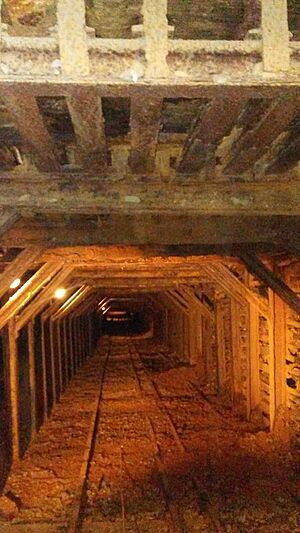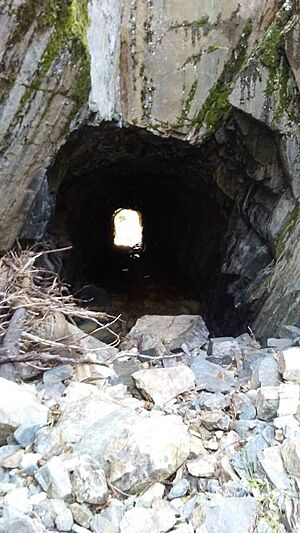Gold Country facts for kids
The Gold Country (also known as Mother Lode Country) is a special historical area in the northern part of California. It's mostly found on the western side of the Sierra Nevada mountains. This region is famous for its rich mineral deposits and gold mines. These mines attracted many people, called the 49ers, during the exciting California Gold Rush in 1849.
Contents
History of Gold Country
When gold was first found in 1848, people from all over the world rushed to California. This huge movement of people brought new challenges, including diseases. There were about 500 mining camps, and 300 of them are still hidden today. Between 1849 and 1855, miners found gold worth about 400 million dollars! Many mines closed down in 1942 because of World War II.
Transportation in Gold Country grew very quickly because of the Gold Rush. California's first railroad ran through this area. By 1860, there were 250 different stagecoach companies helping people travel.
Major Events in Each County
- Amador County – During the Gold Rush, the Kennedy Mine here was the deepest in the world, going down 5,919 feet. The Argonaut Mine operated from 1850 to 1942. In 1922, a fire trapped 47 men in this mine, and they sadly died. This mine also closed because of the war. Amador County was very rural back then, so there wasn't much government. Citizens often took justice into their own hands to solve problems.
- Butte County – Cherokee was a big site for hydraulic mining from 1860 to 1870. It was also the first place in the United States to find diamonds in 1864. In Oroville, a Chinese temple was built in 1863. Chinese workers helped build railroads and mined in the area.
- Calaveras County – This county is famous for the largest gold nugget ever found in the United States. It weighed a huge 195 pounds and was discovered in Carson Hill. In Copperopolis, miners found copper worth 72 million dollars. Many of these copper mines supplied the Union army during the Civil War. The Mitchler Hotel was built in 1856, and the famous outlaw Black Bart stayed there many times.
- El Dorado County – This county is super important to the Gold Country story! This is where gold was first discovered in 1848 by James Marshall at Sutter's Mill. So many people came for the Gold Rush that Sutter's fort was eventually destroyed.
- Mariposa County – Located in the southern part of Highway 49, this county is known for the Ghirardelli Factory, which dates back to 1855–1858. One of the mines in Mariposa County, the Princetown Mine, produced 5 million dollars in gold.
- Nevada County – This county produced the most gold in all of Gold Country, totaling 440 million dollars! The Holbrooke Hotel is one of the oldest hotels still open today, built in 1851. Empire Mine is one of the most famous mines in the area and is now a state park. This mine has 200 miles of tunnels underground and continued working even after the war. It produced 100 million dollars worth of gold. The Nevada County Narrow Gauge Railroad was built in 1876 to help people travel faster between Grass Valley and Nevada City. It closed in 1942. In 1851, mines in North Bloomfield produced a lot of gold but slowed down by 1853. Malakoff Diggings was well-known for its busy hydraulic mining.
- Placer County – Colfax was a major station for supplies coming from the Central Pacific Railroad. Much of the area was known for quartz mining, with about 2 million dollars in quartz found. Placer County was also known for the robber "Rattlesnake Dick" in the 1850s.
- Plumas County – Gold was first found in this county at Rabbit Creek. About 60 million dollars in gold was found in the La Porte area. John Bidwell first discovered gold in the Feather River. Spanish Ranch produced over 100 million dollars worth of gold. In Crescent Mill, miners found a gold vein that was 20 feet thick!
- Sierra County – Allegheny was known for a 163-pound gold nugget. The mine there closed during the war but reopened in 1965 and is still sometimes mined today. In 1992, 70,000 dollars was mined from it. In 1849, gold was first found in the Yuba River in Downieville. A 427-pound nugget was found there! Hydraulic mining happened at Howland Flat and Poker Flat in the 1850s. Poker Flat alone produced 700,000 dollars worth of gold.
- Tuolumne County – In Knights Ferry, there was the largest covered bridge on the west coast, built in 1862. In Jamestown, a 75-pound golden nugget was found. The Sierra Railroad House was built in 1897 and became a popular spot for filming movies. The Eagle Shawmut Mine produced 7.4 million dollars in gold.
- Yuba County – This county was known for dredging rivers, mills, hydraulic mining, and its many small towns. Most towns were built along trails, offering hotels, stores, and bars for new arrivals. The Yuba River once had one of the largest dredgers ever, which dug up 4.8 million ounces of gold. Black Bart was known here for robbing Wells Fargo stagecoaches coming from La Porte. The Colgate Powerhouse started operating in 1899, supplying power to Sacramento and Oroville. One of the most famous towns was Camptonville. Gold was found there in 1850, and the area under the town was so rich that they actually moved the town to get to the gold! Marysville was a main place where people brought their gold to be shipped to San Francisco. Millions of dollars in gold passed through Marysville, which was one of California's biggest cities at the time.
Geology of Gold Country
The Gold Country is located on the western slope of the Sierra Nevada mountains, stretching down to the Sacramento Valley. The oldest rocks in this region are found closer to the Sierra Nevada peaks. They formed about 100 million years ago from ancient sea floors and parts of islands that joined the western edge of North America around 275 million years ago.
The western parts of the Mother Lode are younger, forming about 150 million years ago. These also came from material that hardened on the ocean floor and attached to the continent. Huge amounts of granite pushed their way into these rock formations. Over the last 70 million years, about ten miles of rock above them wore away, making these granite areas visible throughout the Sierra Nevada. In the last 50 million years, rivers and volcanoes added more layers of material, which can be found on top of many high ridges in the Sierra Nevada foothills.
Climate in Gold Country
This part of California has a Mediterranean climate, much like parts of Italy and Spain. This climate is perfect for growing wine grapes, and you'll find over 100 wineries throughout the Gold Country.
Winters are cool and wet, with some snowfall, especially in the higher parts of the eastern Sierra Nevada mountains. Winter temperatures usually range from the upper twenties to the mid-fifties Fahrenheit. Summers are dry and hot, with many days reaching over 100 degrees Fahrenheit. The area gets about 30 inches of rain each year. Many dams were built in the Sierra Nevada to store water, and people in California rely on this water from the mountains.
Transportation in Gold Country
California State Route 49 is the main north-south highway that runs through the Gold Country, connecting many historic mining towns. Major east-west highways include Interstate 80 and U.S. Route 50.
Two Amtrak train routes also pass through the area. The Capitol Corridor train ends in Auburn. The California Zephyr train makes a stop in Colfax.
Counties and Towns in Gold Country
Here are the counties and some of the towns that are part of the Gold Country:




